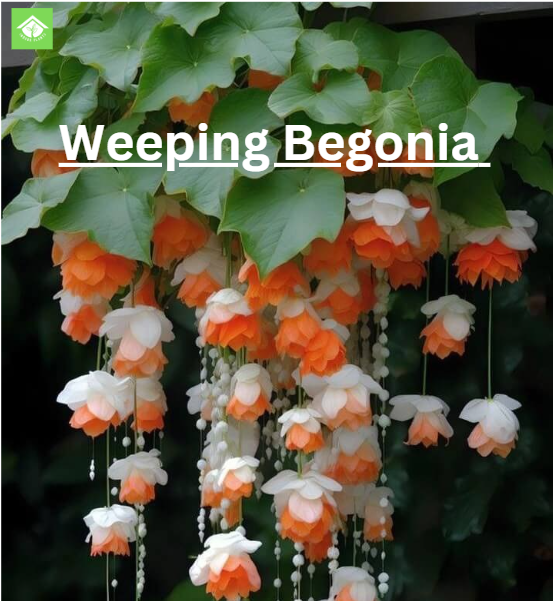The Weeping Begonia is an elegant and flexible indoor plant that has won the hearts of many people. This plant has a cascading habit, lush foliage and delicate blooms which are perfect for anyone who wants to make their living space more beautiful with nature’s touch. Inexperienced or experienced gardeners can opt for the Weeping Begonia since it is very simple to take care of in different indoor environments. This inclusive guide will go through all you need to know about growing and maintaining Weeping Begonia for your plant to stay healthy throughout.
Understanding Weeping Begonia
What is Weeping Begonia?
Weeping begonia (Begonia mucositides) belongs to the popular variety of the Wandering Jew plants. Small tubular flowers that resemble fuchsia blooms hang down from its long and trailing stems. Shiny green leaves with an oval shape create an opulent backdrop on which vibrant blossoms appear.
Why Choose Weeping Begonia as an Indoor Plant?
Due to its low-maintenance nature and stunning looks, weeping begonia grow well as houseplants for people who love gardening indoors. Its trailing stems can be grown in hanging baskets which give them a graceful cascade or placed on shelves where the foliage drapes elegantly. The popularity of this plant among those who love indoor plants is increased by its ability to adapt to different levels of light and purify air.
Ideal Growing Conditions for Weeping Begonia
Light Requirements
Weeping begonias thrive best in bright indirect lighting conditions. Put it near a window that produces gentle sunlight so as to ensure good growth rates with colorful flowers blooming out frequently accordingly. Although it will tolerate some degree of darkness, less light might cause diminished flowering along with spindly growth. Be aware also not to expose this particular species under direct sunshine because this can burn the leaves thus losing their colors.
Temperature and Humidity
Weeping Begonia is a tropical plant that grows well in warm environments at temperatures between 60°F and 75°F (15°C – 24°C). Besides, it thrives in a high-humidity atmosphere with about 50 percent to 60 percent humidity. Dry indoor conditions may necessitate the use of a humidifier or placing your plant on top of water-filled trays of pebbles for increased humidity. You can also mist the plants occasionally so as to maintain adequate moisture.
Soil and Potting Mix
Well-drained potting mix prevents water logging and root rot in weeping begonias. An appropriate blend consists of peat moss, perlite, and organic compost which provides both moisture holding capacity as well as adequate air flow. When buying pots, ensure they have holes at the bottom through which excess water can drain away hence preventing rots at the roots.
Watering and Feeding Weeping Begonia
Watering Schedule
Weeping Begonia should be kept evenly moist but never overwatered. Sometimes give it water once an inch from top soil feels dry when touched by hand Water more frequently during spring-summer period while reduce watering in fall-winter period to avoid very wet soils.
Fertilizing Tips
For the growing season feed your Weeping Begonia every 4-6 weeks using a balanced water soluble fertilizer. Apply fertilizer having equal NPK ratio of nitrogen, phosphorus and potassium (NPK 10-10-10) for excellent lush green leaves besides promoting abundant blooms upon it. In case where the growth rate is slow down reduce feeding during autumn-winter periods.
The Need for Pruning and Maintenance
Pruning to Maintain Shape and Health
Pruning frequently is important because it helps in maintaining the shape and size of your Weeping Begonia plant, encouraging it to grow new leaves while also preventing its stalks from becoming excessively long. Cut off all dead or yellowed leaves along with faded flowers so that the plant looks attractive. By pruning, you can also enhance air circulation around the plants thereby minimizing incidences of fungal diseases.
Repotting Weeping Begonia
Weeping Begonias should be repotted every 1-2 years or when they become root-bound. Select a pot that is larger by 1-2 inches in diameter than what you already have, then use fresh potting mix to fix the soil’s nutrients status. The best time to replant is usually during spring since the plant has enough time to adjust and do well during this growing season.
Common Problems and Solutions
Yellowing Leaves
Overwatering, poor drainage or inadequate light may turn these fussy plants’ foliage yellow hence weakening them significantly. Make sure that your Weeping Begonia is potted in a loamy soil type and receives an indirect light which is ideal for its survival. Change your watering frequency so that water drains out slightly before adding more water again.
Pests and Diseases
Although relatively immune to diseases, spider mites, aphids, or mealybugs can affect weeping begonias occasionally. Regularly check for pests on your plant; if there are signs such as these spray insecticidal soap instantly on them or use neem oil in order to avoid infestation occurring on it at any cost.Well aerated environment around the plant may help prevent such infections including powdery mildew etc.
Styling and Displaying Weeping Begonia Indoors
Display Ideas
To spice up your indoor decor, Weeping Begonia can be displayed in many different ways. A hanging basket of a decorative nature placed near a window that has the stems hanging down beautifully as the foliage is draping over it. Its vivid flowers and leafy branches make it an outstanding centerpiece for any living room.
Companion Plants
Companion plants with matching care requirements like your Weeping Begonia are other indoor plants. Ferns, Calatheas and Peace Lilies do well together because they require similar warm conditions with high relative humidity. Combining various species with different shapes and colors of leaves may give you an amazing indoor garden that brings out natural looks at home.
The Advantages of Indoor Growing of Weeping Begonia
Aesthetic Appeal
The unique mode of growth and the bright blooms characteristic of this variety add sophistication to any interior space where it is put up. This plant’s drooping branches and luxurious foliage provide a calming appeal that enhances the overall beauty of your house.
Air-Purifying Qualities
Like other houseplants, Weeping Begonia helps in air purification by absorbing toxins while releasing oxygen. Introducing this plant into your indoors can help you achieve a healthier living area, improving air quality as well as reducing stress levels. Also Read
Low-Maintenance Care
A gardener who loves low maintenance plants should go for weeping begonias since they need not be attended to so much for them to survive. Under good growing conditions and reasonable attention, these plants will reward you year-round with attractive blossoms and dense greenery.
Techniques for Spreading Weeping Begonia
Stem Cuttings
Propagating Weeping Begonia by taking stem cuttings is a most easy and effective way of making new plants. Choose a healthy stem with at least one leaf node and cut it just below the node. Place the cutting in water or directly into moist potting mix. Keep the soil or water moist until roots develop, which usually takes a few weeks.
Division
If your Weeping Begonia has grown large and bushy, you can propagate it by division. Gently remove the plant from its pot and separate the root ball into smaller sections, each with its own stems and roots. Repot each section in fresh potting mix, and water thoroughly to help the new plants establish.
Conclusion
Weeping Begonia is an ideal houseplant to add elegance as well as nature’s beauty to your home. Its cascading growth habit, bright flowers and easy maintenance make it suitable for both novice gardeners and those experienced in gardening. You will therefore be able to have a healthy flourishing Weeping Begonia that will enrich your living space if you follow what we have discussed above on how to take care of it through this guide for many years ahead.


















